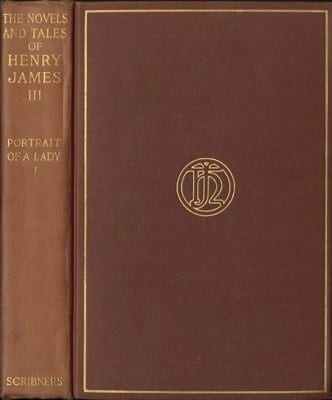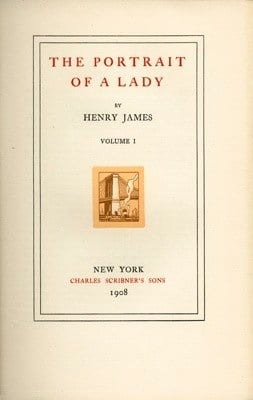The Portrait of a Lady


The New York Edition
The passage of a bilateral copyright agreement between the United States and Great Britain in 1892 transformed the Anglo-American literary marketplace. Long-standing relationships between authors and publishers were vulnerable to new cross-pressures, as expanded marketing opportunities for intellectual property engendered a new kind of literary professional—the agent—who worked, competitively, on behalf of the writers who hired them. Henry James was one of the first to seek an agent’s help, and he found a resolute ally in James Brand Pinker (1863-1922), who took care of the author’s business affairs from 1898 forward.
Long desirous of adding Henry James’s name to their house roster, Charles Scribner’s Sons approached Pinker in 1900 and floated the possibility of issuing a collected edition of James’s work as a way of luring the writer away from his customary publishers in the United States. James demurred at first, but seized the opportunity to give Scribner’s most of his soon forthcoming titles: The Sacred Fount (1900), The Wings of the Dove (1902), The Better Sort (1903), and The Golden Bowl (1904). Later, when James was anticipating his return to his homeland to lecture and tour the country, the author prompted Pinker to reopen the question of a collected edition with Scribner’s. Even though the market seemed less propitious for such an enterprise, the publisher knew that a collected edition of the writer’s work would consolidate and disseminate the perception of Henry James as a Scribner author. Despite some misgivings, then, the New York Edition was commissioned. After clearing many hurdles, the Edition in twenty-four volumes was published by subscription, two volumes issued roughly every other month from December 1907 through July 1909.
The whole complicated history of the New York Edition can rightly be seen as a contest of competing intentions—Scribner’s wanting to produce a series in line with the other “deluxe” editions they were selling, and James trying to reinvent the genre by making his edition distinct from others in what by then was an overly crowded field. The author’s wholesale textual revisions (especially of earlier works, including The Portrait of a Lady), the magisterial (if somewhat forbidding) Prefaces, the deliberately suggestive (rather than literally imagined) frontispieces, the thematic collocation of titles (rather than a strictly chronological sequence): in every respect James was deviating from consumer expectations and publishing tradition.
No one knew this better than Scribner’s, who then nervously attempted to convert each of these deflections into a marketing coup, as reflected in their advertising prospectus for the Edition. “To give the edition a literary unity such as, it is believed, no collected edition of any author’s work heretofore issued has every enjoyed,” Scribner’s advertising claimed,
Mr. James has devoted many months to the most careful and scrupulous revision of all the novels and tales, particularly the early ones. Those written many years ago, the first fruits of his genius, have thus been brought into alignment of style, color and general literary presentment with the work of his maturity—the work that has placed him in his present unrivalled position. . . . A still more important and equally novel feature is the set of Special Prefaces which Mr. James has prepared for the different volumes of the New York Edition. Nothing of the kind has ever been attempted. . . . The illustration of the edition has also been treated on a novel and, it is believed, particularly successful plan.
Publishing hyperbole could not altogether conceal Scribner’s anxiety about the very novelties they were obliged to tout. More circumspectly, the British publisher who handled the New York Edition (Macmillan) omitted any reference to James’s revisions in its prospectus, fearful that such information would discourage potential buyers.
About his revisions James was adamantly proud. “It has made me ten years older,” he grimly told one correspondent, “but it has really made my poor old books, I think, twenty or thirty years younger.” For James’s publishers, however, that fountain of youth seemed polluted by the endless streams of wriggling interlineations that criss-crossed the proof sheets he forwarded to them.
A sample page of James’s revision of The Portrait of a Lady for the New York Edition.
Courtesy of the Houghton Library, Harvard University (MS Am 1237.17, p. 357)
The barrage of journalistic caricature that had shadowed James during and after his recent American lecture tour (1904-05), ridiculing his supposedly Byzantine sentences, must have added to his publishers’ anxiety about how well the much-revised texts would be received.
Struggling to muffle their qualms about the invasive nature of James’s emendations, which they feared would discourage sales, Scribner’s preferred to address that issue in their Prospectus with a liberal dose of rose-color:
Purged thus of crudities while retaining their freshness these productions [the earlier books] take their equal place in the harmony of the author’s entire artistic output, and the whole edition thus constitutes an elaborate edifice whose design and execution are absolutely unique in their kind owing to their complete unity of effect.
James was equally resolute. In revising The Portrait of a Lady he affirmed, “I shall have hugely improved the book—& I mean not only for myself, but for the public: this is beyond question.” Equipped now with electronic texts of all six different versions of the novel, visitors to this website can discover for themselves whether the author’s confidence was justified.
For a complete collation of textual variants and fuller discussion of their significance, readers should consult the print edition of The Portrait of a Lady, published in 2016.
1908 New York Edition – Volume I
1908 New York Edition – Volume II

